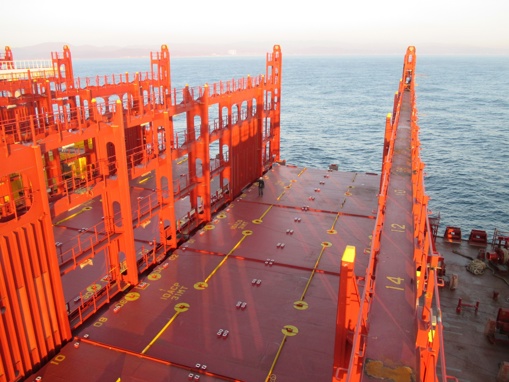Container Ship Cargo Solution
MacGregor Container Ship Cargo Solution
“One layer (tier) more payload, loaded - not empty containers, only on midship area on deck of 14000TEU ship means about 3-5 million USD additional earning annually for ship operator”
How can you ensure the best-performing cargo system on your ship?
While the process can be straightforward in some aspects, it also requires careful attention and effort. However, the results are well worth it.

Cargo System Insights: Effective cargo solution for container ships
Why is an effective cargo solution crucial for a container ship?
Welcome to MacGregor Cargo System Insights with Arto Toivonen and Toni Mäenpää. In this video, we explore why an effective cargo solution is crucial, not only for shipowners, but also shipyards.
Shipyards develop specific vessel types to meet market demands, address shipowner inquiries, and differentiate themselves from competitors.
By integrating MacGregor’s optimised cargo system early, you can make a significant difference compared to standard vessels and gain a competitive edge.
Check out the video to learn more.
Cargo System Insights: Cargo solution
Welcome to MacGregor Cargo System Insights with Arto Toivonen, Mikko Tarmas, Tero Sairanen and Atte Virta. Today we talk about MacGregor Cargo solution.
Why do only the boldest industry players secure the most profitable container cargo systems?
Check out the video, straight talk about the solution approach

Solution benefits
The MacGregor Container Ship Cargo Solution offers added value to shipowners, shipyards, and other stakeholders involved in the shipbuilding process:
- Increased Return on Investment (ROI): The MacGregor Containership Cargo Solution addresses how a ship can deliver the best return on investment for shipowners.
- Maximized Utilization Rates: Early recognition and incorporation of cargo profile requirements into system planning maximizes a containership's utilization rates.
- Enhanced Earning Capabilities: By optimizing loading ability and the efficiency of the cargo handling system, the ship's earning capabilities will be increased.
- Emission Reduction: The more efficient the cargo system is, the greater is the number of TEU’s a ship can carry, which in turn reduces the emissions per carried TEU, and subsequently per transported commodity.
- Added Value to Shipyard Offerings: MacGregor Containership Cargo Solution allows shipyards to sell ships with optimized payload capacity, adding value to their customers' vessels.
“Ship’s earning capacity is the cornerstone. Thinking the big picture makes the system. Losing focus in one single part of the big picture can destroy the earning of the ship”
Collaborative Model
MacGregor Container Ship Cargo Solution represents a collaborative model in the industry, going beyond the traditional 'order to delivery' process for mutual benefit.
The benefits collectively highlight the advantages of
- early planning
- optimization
- tailored services
- collaboration
MacGregor's holistic approach involves collaboration from an early stage, ensuring commitments from all parties involved, leading to the delivery of a ship with the highest possible payload capacity.


Customized solution
MacGregor Container Ship Cargo Solutions are customized to include elements that provide value to the shipowner, ensuring vessels can carry the agreed-upon number of payload containers.
“Solution is not only making a new loose lashing system. It is optimizing all the parts of the vessel’s container cargo system to every individual ship operator’s routes and cargo profile”
The MacGregor approach Reference – Al Muraykh
World record container ship
- 18.601 TEU carried onboard the UASC M.V. Al Muraykh arriving London gateway January 2016 - west bound!
- Made possible by early collaboration and MacGregor solutions
- All parts of cargo system are from MacGregor: hatch covers, lashing bridges, lashings, fixed fittings.


MacGregor Cargo Boost
Cargo Boost for container ships ensures more competitive vessels by maximising cargo space utilisation, efficiency and lower emissions per transported unit of cargo.